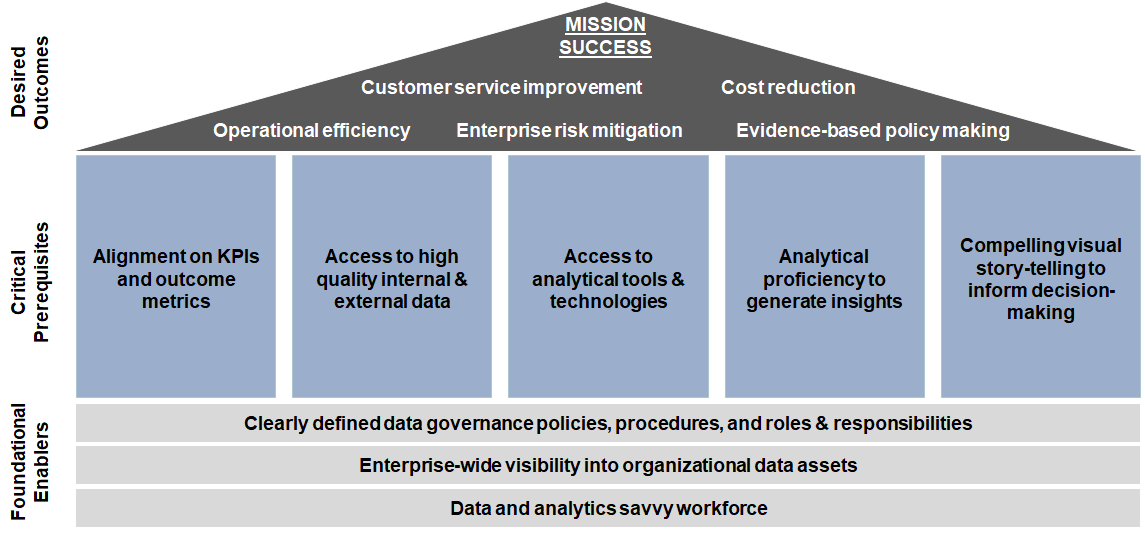The first step is to prioritize the outcomes to be enabled by better data-driven decision-making.
The government is looking to adapt private sector best practices for leveraging data and analytics. Developing a Federal Data Strategy to leverage data as a strategic asset is one of the three Cross-Agency Priority (CAP) goals in the President’s Management Agenda.
The Federal Data Strategy Development Team, comprised of a core group of cross-disciplinary data experts from across the Federal Government, has already developed a set of 10 principles and a draft set of nearly 50 practices to guide the development of a comprehensive data strategy. The team aims to release an action plan in April 2019 for agencies to implement these principles and practices.
There is no “one size fits all” approach to execution. While nearly all CFO Act agencies prioritize data / analytics related opportunities in their 2018-22 strategic plans, different agencies (and even bureaus / offices / programs within an agency) are currently at different stages of data and analytics maturity, and furthermore not every organization needs to achieve the same target maturity level.
Agency leaders should begin by defining an end-state vision for data strategy and data-driven decision-making that supports their mission objectives and goals. They can then assess their current data and analytics maturity levels, prioritize and adapt the practices being developed by the Federal Data Strategy Team based on their desired end-state and current maturity, and identify the right next steps for implementation.
The first step in defining an end-state vision is to prioritize the outcomes to be enabled by better data-driven decision-making, as illustrated below. Leaders can then determine which critical prerequisites and foundational enablers to strengthen within their organizations to drive these outcomes.
Next, plan out a series of data / analytics pilot projects. Implementing a well-designed and comprehensive data strategy can take time depending on where your organization falls on the data / analytics maturity curve, especially given the cultural and mindset / skillset shifts that are needed for transformations of this scale to succeed. In our experience, leaders are well served by starting small and executing rapidly on a series of projects (agile pilots) demonstrating how data and analytics can drive better decision-making and mission outcomes, and using this momentum to build organizational commitment to change.
Execute pilots quickly by scoping them at a sufficiently granular level. For instance, if driving customer service improvements via better data-driven decision-making is an organizational priority, it will be critical to scope “customer service” down to a meaningful level where data and analytics can be brought to bear rapidly, and outcomes can be measured. In one agency, examples included pilot projects focused on using data and advanced analytics to reduce contact center response times and improve the effectiveness of outreach and education efforts. It is at this level that one can quickly address the prerequisites highlighted earlier, such as, determining what internal & external data to analyze and how to best present the analytical insights to drive better decision-making.
Publicize pilot learnings and successes to build support for broader data strategy. Leaders should use every opportunity to remind the organization of the benefits of a broader data and analytics transformation. For instance, if the initial maturity assessment showed the organization to be weak at having a handle on all its data assets and a pilot project was focused on inventorying the data assets, it will be critical to highlight to different stakeholders (e.g., policy makers, operational executives) how they can now readily access authoritative sources of high-value data assets and use this information to make better decisions.
In subsequent posts, we will continue exploring practical, actionable tactics and ideas that public sector leaders can quickly implement to instill a data-driven culture and tools to drive smarter operational decision-making. In our view, driving operational excellence in the public sector doesn’t have to be hard!
We invite you to participate in and shape this dialogue. Get in touch with us to discuss key data and analytics priorities for your organization, areas where you believe you have made significant progress and what helped you achieve those outcomes, and potential challenges that remain to be overcome.




